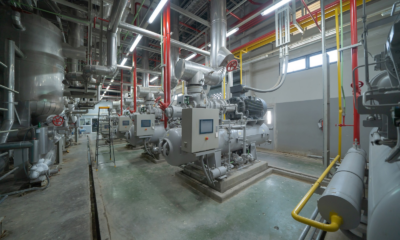REAL ESTATE
Benefits of Renting Portable Classrooms
Portable classrooms for rent provide a practical solution for schools, institutions, and organizations, allowing them to design custom learning environments.
Utilizing these innovative classrooms enables educators to keep up with the changing needs of students and staff. Here are several benefits associated with modular classroom rentals:
Enhanced Flexibility
Modular classrooms are flexible and can be moved around depending on a school’s needs. They provide a convenient and time-saving solution for creating additional space for students before the school year begins.
Some schools experience unexpected population increases, district boundary adjustments, or changes in student enrollment. If these changes occur, portable classrooms can be moved on or off campus to accommodate the fluctuating number of students.
Portable classrooms can also be used for various purposes beyond traditional classrooms, such as administrative offices, libraries, labs, and daycare facilities. This versatility maximizes the utilization of space and resources.
Quick Installation
Delivering and setting up a portable classroom rental requires significantly less time than erecting a concrete and steel building. This makes it possible for portable classrooms to be rented and installed if an unexpected event occurs, such as a natural disaster or nearby school closure.
The students’ learning routines are not halted due to insufficient structures. Portable classrooms enable students to maintain access to safe and useful learning spaces.
Customizable Design and Amenities
Various features of portable classrooms are customizable to suit a wide range of purposes. This includes the layout, size, and interior finishes.
Providers also carry modern portable classrooms that come equipped with all the necessary amenities, such as heating and cooling systems, technology integration capabilities, and lighting fixtures. This level of customization makes sure that the space is comfortable and functional for its intended educational use.
Sustainable Options
Some portable classrooms may be constructed using eco-friendly materials or practices that minimize waste and reduce environmental impact. These materials can include recycled steel, wood, and glass. Companies that rent out portable classrooms can also offer sustainable features, such as LED lighting and energy-efficient heating and cooling systems.
Minimal Disruption
Portable classrooms for rent are built off-site and delivered fully assembled, minimizing inconveniences associated with on-site construction. These inconveniences may include noise, dust, and limited access to certain areas of the campus.
Teachers can also choose to have their modular classrooms installed during a summer or holiday break, further reducing disruptions to students and learning.
Temporary Solutions
Renting portable classrooms offers a temporary solution for short-term space needs. It is ideal for schools facing capacity challenges, hosting temporary events or programs, or undergoing construction projects that require temporary classrooms. Schools exploring new educational initiatives or pilot programs may also opt for portable classrooms. This allows them to test the program’s feasibility and impact before making long-term commitments or investments in permanent infrastructure.
Enhanced Accessibility
Modular classrooms can be placed in accessible areas, such as near the main school building or in a nearby parking lot. This can make it easier for teachers to access resources, administrative support, and facilities like restrooms and staff rooms.
Portable classrooms can also be adjusted to incorporate ramps and wide doorways for improved accessibility. By renting and installing portable classrooms with such accessibility features, schools can provide an all-inclusive learning environment that is relevant to all students.
Explore Portable Classrooms for Rent
Various organizations, including educational institutions, corporate training centers, nonprofit organizations, and daycare centers, can experience the convenience and versatility of portable classrooms for rent. These modular structures offer accessible and sustainable options for educators and other staff members. They are adaptable to many needs and services. Rent a high-quality portable classroom today to create an educational environment tailored to your needs.
REAL ESTATE
Commercial Real Estate Post-Pandemic: Strategies for Recovery and Growth
Commercial Real Estate Post-Pandemic: Strategies for Recovery and Growth
The commercial real estate sector has faced unprecedented challenges in the wake of the COVID-19 pandemic. As businesses shut down, employees shifted to remote work, and consumer behavior changed, the demand for commercial spaces plummeted. However, as we move towards recovery, the commercial real estate industry is adapting and strategizing for growth post-pandemic.
1. Embracing Flexible Workspaces
One of the key strategies for recovery and growth in commercial real estate post-pandemic is the adoption of flexible workspaces. With the rise of remote work and hybrid work models, businesses are looking for office spaces that can accommodate changing needs. This shift towards flexible workspaces includes shared offices, co-working spaces, and hot-desking arrangements.
2. Repurposing Unused Spaces
To adapt to the changing market dynamics, commercial real estate owners are exploring the repurposing of unused spaces. This could involve converting office buildings into mixed-use developments, transforming retail spaces into fulfillment centers, or creating experiential spaces that cater to the new demands of consumers.
3. Leveraging Technology
Technology plays a crucial role in the recovery and growth of commercial real estate post-pandemic. From virtual property tours to digital marketing strategies, leveraging technology can help real estate professionals reach a wider audience, streamline operations, and enhance the overall customer experience.
4. Sustainable Development Practices
In the post-pandemic era, sustainability has become a key focus for commercial real estate stakeholders. Implementing sustainable development practices not only aligns with environmental goals but also attracts tenants and investors who prioritize eco-friendly spaces. Strategies such as energy-efficient buildings, green certifications, and waste reduction initiatives can drive growth in the long term.
5. Enhancing Health and Safety Measures
Health and safety have become top priorities for tenants and employees in the wake of the pandemic. Commercial real estate owners are investing in enhanced cleaning protocols, touchless technologies, and air quality improvements to create safe and healthy environments. These measures not only address current concerns but also position properties for long-term success.
6. Collaborating with Tenants
Collaboration with tenants is essential for the recovery and growth of commercial real estate post-pandemic. Building strong relationships with tenants, understanding their evolving needs, and offering customized solutions can help landlords retain existing tenants and attract new ones. This partnership approach fosters loyalty and drives occupancy rates.
7. Diversifying Investment Portfolios
Diversification is key to mitigating risks and seizing opportunities in the commercial real estate market. Post-pandemic, investors are exploring diverse asset classes, geographic locations, and property types to spread their risk and maximize returns. By diversifying their investment portfolios, stakeholders can adapt to market fluctuations and capitalize on emerging trends.
8. Adapting Lease Structures
The traditional lease structures in commercial real estate are evolving post-pandemic to accommodate changing market dynamics. Landlords are offering more flexible lease terms, rent concessions, and value-added services to attract and retain tenants. By adapting lease structures to meet the needs of tenants, property owners can maintain occupancy levels and drive revenue growth.
9. Monitoring Market Trends
Staying informed about market trends and emerging opportunities is crucial for the recovery and growth of commercial real estate post-pandemic. By monitoring factors such as supply and demand dynamics, rental rates, economic indicators, and consumer behavior, real estate professionals can make informed decisions and stay ahead of the competition.
10. Investing in Talent Development
As the commercial real estate industry evolves post-pandemic, investing in talent development is essential for long-term success. By upskilling employees, fostering a culture of innovation, and attracting top talent, companies can build a competitive edge and drive growth. Investing in talent development ensures that organizations have the skills and expertise to navigate changing market conditions.
FAQs
1. How has the COVID-19 pandemic impacted the commercial real estate sector?
The COVID-19 pandemic has significantly impacted the commercial real estate sector, leading to a decrease in demand for office spaces, retail properties, and hospitality venues. Many businesses have shifted to remote work, resulting in vacant commercial spaces and reduced foot traffic in retail establishments.
2. What are some strategies for landlords to attract tenants in the post-pandemic era?
Landlords can attract tenants in the post-pandemic era by offering flexible lease terms, implementing health and safety measures, providing value-added services, and creating engaging tenant experiences. By understanding the evolving needs of tenants and adapting their offerings accordingly, landlords can enhance tenant satisfaction and retention.
3. How can technology help drive growth in commercial real estate post-pandemic?
Technology can help drive growth in commercial real estate post-pandemic by enabling virtual property tours, digital marketing campaigns, data analytics, and smart building solutions. By leveraging technology, real estate professionals can enhance operational efficiency, improve tenant experiences, and reach a wider audience of potential buyers and tenants.
4. What role does sustainability play in the recovery and growth of commercial real estate post-pandemic?
Sustainability plays a crucial role in the recovery and growth of commercial real estate post-pandemic by attracting environmentally conscious tenants and investors, reducing operating costs, and enhancing the long-term value of properties. Implementing sustainable development practices such as energy efficiency, green certifications, and waste reduction initiatives can differentiate properties in the market and drive demand.
REAL ESTATE
Sustainable Architecture: Designing Buildings for Environmental Conservation
Sustainable Architecture: Designing Buildings for Environmental Conservation
Sustainable architecture is a design approach that aims to minimize the negative environmental impact of buildings by efficiently using resources, reducing waste, and creating healthy living environments. It focuses on incorporating renewable energy sources, utilizing eco-friendly materials, and implementing innovative technologies to reduce carbon footprint and promote environmental conservation. In today’s world, where climate change and environmental degradation are pressing issues, sustainable architecture plays a crucial role in creating a more sustainable future for generations to come.
Sustainable architecture encompasses various principles and strategies that architects and designers employ to create environmentally friendly buildings. From energy-efficient designs to green building materials, sustainable architecture offers a holistic approach to construction that considers the environmental, social, and economic aspects of a building project. By integrating sustainable practices into the design and construction process, architects can significantly reduce the environmental impact of buildings and contribute to a more sustainable built environment.
Key Principles of Sustainable Architecture
Sustainable architecture is guided by several key principles that shape the design and construction of environmentally friendly buildings. These principles include:
1. Energy Efficiency
Energy efficiency is a fundamental aspect of sustainable architecture. By designing buildings that optimize energy use and reduce waste, architects can minimize the carbon footprint of a structure. Strategies such as passive solar design, natural ventilation, and high-performance insulation help reduce energy consumption and promote a more sustainable built environment.
2. Use of Renewable Energy Sources
Incorporating renewable energy sources such as solar panels, wind turbines, and geothermal systems into building designs can help reduce reliance on fossil fuels and lower greenhouse gas emissions. By harnessing clean and renewable energy, sustainable buildings can operate more efficiently and sustainably over the long term.
3. Water Conservation
Water conservation is another critical aspect of sustainable architecture. By implementing water-saving fixtures, rainwater harvesting systems, and greywater recycling technologies, architects can reduce water consumption and minimize the strain on local water resources. Sustainable buildings aim to achieve water efficiency and promote responsible water management practices.
4. Use of Eco-Friendly Materials
Choosing eco-friendly materials such as recycled wood, bamboo, cork, and low-VOC paints is essential in sustainable architecture. These materials have lower environmental impacts, reduce waste, and promote healthier indoor air quality. By selecting sustainable materials, architects can create buildings that are environmentally responsible and contribute to a more sustainable construction industry.
5. Passive Design Strategies
Passive design strategies focus on utilizing natural elements such as sunlight, wind, and shade to enhance the comfort and efficiency of a building. By orienting buildings to maximize natural light, incorporating shading devices, and optimizing natural ventilation, architects can reduce the need for artificial heating and cooling systems, leading to energy savings and improved occupant comfort.
6. Green Roof and Living Wall Systems
Green roof and living wall systems are innovative solutions that help mitigate the urban heat island effect, improve air quality, and promote biodiversity in urban areas. By incorporating vegetation into building designs, architects can create sustainable green spaces that enhance the environmental performance of a structure and contribute to a more sustainable urban environment.
7. Adaptive Reuse and Retrofitting
Adaptive reuse and retrofitting involve repurposing existing buildings and structures to reduce waste and extend their lifespan. By renovating older buildings with sustainable design features, architects can preserve architectural heritage, conserve resources, and reduce the environmental impact of new construction. Sustainable architecture emphasizes the importance of adaptive reuse and retrofitting in creating a more sustainable built environment.
8. Life Cycle Assessment
Life cycle assessment (LCA) is a methodology used in sustainable architecture to evaluate the environmental impacts of a building throughout its entire life cycle, from construction to demolition. By considering the environmental consequences of materials selection, construction processes, and building operations, architects can make informed decisions that minimize the overall environmental footprint of a structure and promote sustainability.
9. Biophilic Design
Biophilic design integrates natural elements and patterns into the built environment to enhance human health and well-being. By incorporating elements such as natural light, greenery, and water features into building designs, architects can create spaces that promote connection to nature, reduce stress, and improve overall quality of life. Biophilic design principles are essential in sustainable architecture to create healthy and sustainable living environments.
10. Community Engagement and Social Equity
Community engagement and social equity are integral aspects of sustainable architecture that prioritize the needs and well-being of local communities. By involving stakeholders in the design process, addressing social issues, and promoting inclusivity, architects can create buildings that serve the greater good and contribute to a more sustainable and equitable society. Sustainable architecture aims to foster community resilience, social cohesion, and environmental justice through collaborative design approaches.
Frequently Asked Questions (FAQs)
1. What are the benefits of sustainable architecture?
Sustainable architecture offers numerous benefits, including reduced energy consumption, lower operating costs, improved indoor air quality, enhanced occupant comfort, and minimized environmental impact. By incorporating sustainable design principles, architects can create buildings that promote environmental conservation, social well-being, and economic prosperity.
2. How can sustainable architecture help combat climate change?
Sustainable architecture plays a crucial role in combating climate change by reducing greenhouse gas emissions, promoting energy efficiency, and minimizing resource consumption. By designing buildings that operate sustainably and efficiently, architects can contribute to global efforts to mitigate the impacts of climate change and create a more resilient built environment.
REAL ESTATE
Investing in Rental Properties: Maximizing Returns in a Competitive Market
Investing in Rental Properties: Maximizing Returns in a Competitive Market
Investing in rental properties can be a lucrative venture, especially in today’s competitive real estate market. With the right strategies and knowledge, investors can maximize their returns and build a successful rental property portfolio. In this comprehensive guide, we will explore the key factors to consider when investing in rental properties and how to navigate the competitive market to achieve optimal returns.
1. Understanding the Rental Property Market
Before diving into the world of rental property investments, it is crucial to have a solid understanding of the market dynamics. Conduct thorough research on the local real estate market, rental demand, vacancy rates, and rental prices in the area. Analyze market trends and economic indicators to identify potential investment opportunities.
2. Setting Investment Goals
Define your investment goals and objectives before purchasing a rental property. Determine whether you are looking for long-term appreciation, steady rental income, or a combination of both. Establish a clear investment strategy that aligns with your financial goals and risk tolerance.
3. Financial Planning and Budgeting
Create a detailed financial plan and budget for your rental property investment. Consider all expenses, including property acquisition costs, maintenance and repairs, property management fees, property taxes, insurance, and vacancy reserves. Calculate your expected rental income and cash flow to ensure the investment is financially viable.
4. Property Selection and Due Diligence
Carefully select the right rental property based on your investment criteria and budget. Conduct thorough due diligence, including property inspections, title searches, and rental property analysis. Evaluate the property’s condition, location, rental potential, and market value to make an informed investment decision.
5. Financing Options and Mortgage Considerations
Explore different financing options for purchasing a rental property, such as conventional mortgages, FHA loans, or private financing. Compare interest rates, loan terms, and down payment requirements to find the most suitable financing option for your investment. Consider the impact of mortgage payments on your cash flow and overall investment returns.
6. Property Management and Tenant Screening
Effective property management is essential for maximizing returns on rental properties. Consider hiring a professional property management company to handle tenant screening, rent collection, maintenance, and property inspections. Implement strict tenant screening criteria to attract reliable tenants and minimize vacancy rates.
7. Rental Property Marketing and Advertising
Develop a comprehensive marketing strategy to attract potential tenants to your rental property. Utilize online rental platforms, social media, and local advertising channels to promote your rental listings. Highlight the property’s unique features, amenities, and rental terms to attract quality tenants and maximize rental income.
8. Rental Property Maintenance and Upgrades
Regular maintenance and upgrades are essential for preserving the value of your rental property and attracting tenants. Implement a proactive maintenance plan to address repairs, landscaping, and property improvements promptly. Consider investing in upgrades that enhance the property’s appeal and rental value, such as kitchen renovations or energy-efficient upgrades.
9. Monitoring Market Trends and Rental Rates
Stay informed about market trends, rental rates, and economic indicators to make informed investment decisions. Monitor rental market dynamics, vacancy rates, and rental price trends in your area. Adjust your rental strategy and pricing strategy based on market conditions to maximize rental income and occupancy rates.
10. Diversification and Portfolio Management
Diversify your rental property portfolio to spread risk and maximize returns. Consider investing in different types of properties, locations, and rental markets to create a balanced portfolio. Regularly review and assess your portfolio performance, cash flow, and investment goals to make strategic decisions for portfolio growth and optimization.
FAQs
1. How can I finance my rental property investment?
To finance your rental property investment, you can explore options such as conventional mortgages, FHA loans, or private financing. Compare interest rates, loan terms, and down payment requirements to find the most suitable financing option for your investment.
2. What factors should I consider when selecting a rental property?
When selecting a rental property, consider factors such as location, property condition, rental potential, market value, and rental demand. Conduct thorough due diligence, property inspections, and rental property analysis to make an informed investment decision.
3. How can I attract quality tenants to my rental property?
To attract quality tenants, develop a comprehensive marketing strategy that highlights the property’s unique features, amenities, and rental terms. Utilize online rental platforms, social media, and local advertising channels to promote your rental listings and attract potential tenants.
4. What are the key benefits of hiring a property management company?
Hiring a property management company can help streamline property management tasks, such as tenant screening, rent collection, maintenance, and property inspections. Property management companies can also help minimize vacancy rates, handle tenant issues, and ensure compliance with rental regulations.
5. How can I maximize rental income on my property?
To maximize rental income, regularly monitor market trends, rental rates, and economic indicators to adjust your rental strategy and pricing strategy. Implement proactive maintenance, upgrades, and marketing strategies to attract quality tenants and optimize rental income.
6. What are the tax implications of owning rental properties?
Owning rental properties has tax implications, including rental income taxes, property taxes, depreciation deductions, and capital gains taxes. Consult with a tax professional or accountant to understand the tax implications of owning rental properties and maximize tax benefits.
-
Blog2 months ago
manhwa18cc
-

 Tech2 weeks ago
Tech2 weeks agoHow Technology Can Be a Reliable Ally in Supporting Better Sleep
-

 LIFESTYLE2 weeks ago
LIFESTYLE2 weeks agoElevate Your Dining Experience with Luxury Dining Tables from Serena & Lily
-

 Blog2 weeks ago
Blog2 weeks agoEverything You Need to Know About Industrial Chillers
-

 Blog2 weeks ago
Blog2 weeks agoUnraveling the Mysteries of “Cat in the Chrysalis Spoilers”
-

 Tech1 week ago
Tech1 week agoRevitalizing Cognitive Function: Exploring Peptide Solutions for Brain Health
-
Blog1 month ago
www .flyarchitecture . net
-

 Tech2 weeks ago
Tech2 weeks agoztec100.com – Empowering Your Health Journey in 2024
